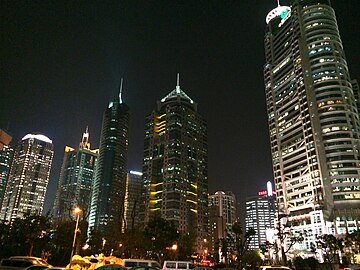Pudong
Coordinates: 31°14′05″N 121°30′23″E / 31.23472°N 121.50639°E
Pudong
浦东新区 | |
|---|---|
District & State-level new area | |
| Pudong New Area | |
 Lujiazui from The Bund | |
 | |
 Location within Shanghai | |
| Country | People's Republic of China |
| Municipality | Shanghai |
| District Gov't Established | 1993 |
| Government | |
| • CPC Pudong District Secretary | Weng Zuliang |
| • District Governor | Hang Yingwei (杭迎偉) |
| Area | |
| • Total | 1,210.4 km2 (467.3 sq mi) |
| Population (2018 est.) | |
| • Total | 5,599,600 |
| • Density | 4,600/km2 (12,000/sq mi) |
| Time zone | UTC+08:00 (China Standard Time) |
| Postal code | 200120 |
| Area code(s) | 021 |
| GDP | 2019[1] |
| - Total | ¥1.27343 trillion $184.595 billion (nominal) $364.149 billion (PPP) |
| - Per capita | ¥229,092 $33,209 (nominal) $65,511 (PPP) |
| Website | Pudong.gov.cn |
| Pudong | |||
|---|---|---|---|
 "Pudong" in Simplified (top) and Traditional (bottom) Chinese characters | |||
| Simplified Chinese | 浦东 | ||
| Traditional Chinese | 浦東 | ||
| Postal | Pootung | ||
| Literal meaning | "East of the Pu [River]" | ||
| |||
Pudong is a district of Shanghai located east of the Huangpu River across from the historic city center of Shanghai in Puxi. The name refers to its historic position as "The East Bank" of the Huangpu River, which flows through central Shanghai, although it is now administered as the Pudong New Area, a state-level new area which extends all the way to the East China Sea.
The traditional area of Pudong is now home to the Lujiazui Finance and Trade Zone and the Shanghai Stock Exchange and many of Shanghai's best-known buildings, such as the Oriental Pearl Tower, the Jin Mao Tower, the Shanghai World Financial Center, and the Shanghai Tower. These modern skyscrapers directly face Puxi's historic Bund, a remnant of former foreign concessions in China. The rest of the new area includes the Port of Shanghai, the Shanghai Expo and Century Park, Zhangjiang Hi-Tech Park, Shanghai Pudong International Airport, the Jiuduansha Wetland Nature Reserve, Nanhui New City, and the Shanghai Disney Resort.
History[]
Pudong—literally "The East Bank of the Huangpu River"—originally referred only to the less-developed land across from Shanghai's Old City and foreign concessions. The area was mainly farmland and only slowly developed, with warehouses and wharfs near the shore administered by the districts of Puxi on the west bank: Huangpu, Yangpu, and Nanshi. Pudong was originally established as a county in 1958 until 1961 which the county was split among Huangpu, Yangpu, Nanshi, Wusong and Chuansha County. On October 1, 1992 the original area of Pudong County and Chuansha County merged and established Pudong New Area.
In 1993, the Chinese government set up a Special Economic Zone in Chuansha, creating the Pudong New Area. The western tip of the Pudong district was designated as the Lujiazui Finance and Trade Zone and has become a financial hub of modern China. Several landmark buildings were constructed, including the Oriental Pearl Tower, and the supertall Jin Mao Building (420.5 m or 1,380 ft), Shanghai World Financial Center (494 m or 1,621 ft) and Shanghai Tower (632 m or 2,073 ft), the world's first trio of adjacent supertall skyscrapers. These buildings—all along Century Avenue and visible from the historic Bund—now form the most common skyline of Shanghai.
On May 6, 2009, it was disclosed that the State Council had approved the proposal to merge Nanhui District with Pudong and comprise the majority of eastern Shanghai. In 2010, Pudong was host to the main venues of the Shanghai Expo, whose grounds now form a public park.
Pudong New Area consist of the original Pudong County (northeastern portion of Shanghai County), Chuansha County, and Nanhui County.
Government[]
Districts of the Direct-Controlled Municipality of Shanghai are administratively on the same level as prefecture-level cities. However, the government of Pudong has a status equivalent to that of a sub-provincial city, which is a half-level above a prefecture-level city. This is due to Pudong's size and importance as the financial hub of China. The Pudong Communist Party Secretary is the top office of the district, followed by the district governor of Pudong. The Pudong party chief is customarily also a member of the Shanghai Party Standing Committee.[citation needed]
On April 27, 2015, the People's Government of Pudong New Area is working with China (Shanghai) Pilot Free-Trade Zone Administrative Committee.[2]
Demographics[]
Pudong is bounded by the Huangpu River in the west and the East China Sea in the east. Pudong is distinguished from Puxi ("West Bank"), the older part of Shanghai. It has an area of 1,210.4 square kilometres (467.3 sq mi) and according to the 2010 Census, a population of 5,044,430 inhabitants, 1.9 million more than in 2000. Currently, at least 2.1 million of residents of Pudong are newcomers from other provinces or cities in China.[3]
Pudong is the most populous district in Shanghai. According to the 2010 Census, it has 5,044,430 people in 1,814,802 families, around 1/4 of Shanghai's total population, an explosive growth since the last census thanks to immigrants.[4] Pudong's resident population growth is well above national average because it is a popular immigration destination. The 2010 census shows a 58.26% increase in the last decade, or an annual pace of 4.7%. In particular, the district saw am immigration growth of 189.5%, or an annual pace of 11.22%.
Excluding immigrants, the birth rate is 0.806% while the death rate is 0.729, resulting a net growth of 0.077%. The total fertility rate is 1.03, well below the replacement level.[5] The district actually has a negative registered household population growth if immigrants are excluded, thus the growth is purely driven by immigration.
The 2010 Census shows a population density of 3,909/km2. About 3/4 of the population live in the northern part and part of city center called "Northern Territory". 1/4 live in the "Southern Territory" that was the Nanhui District. The Northern Territory has a 6,667 population density, while the Southern Territory has 1,732/km2. Suburbs saw a greater increase in population during 2000–2010 with the help of the city's suburb expansion policy. Some counties in the traditional city center saw a population decrease.
Subdistricts and towns[]
| Name | Chinese (S) | Hanyu Pinyin | Shanghainese Romanization | Population (2010)[6] | Area (km2) |
|---|---|---|---|---|---|
| 潍坊新村街道 | Wéifāng Xīncūn Jiēdào | vij vaon sin tsen ka do | 100,548 | 3.89 | |
| Lujiazui Subdistrict | 陆家嘴街道 | Lùjiāzuǐ Jiēdào | loq ka tzyu ka do | 112,507 | 6.89 |
| 周家渡街道 | Zhōujiādù Jiēdào | tzoe ka du ka do | 144,668 | 5.52 | |
| 塘桥街道 | Tángqiáo Jiēdào | daon djio ka do | 76,916 | 3.86 | |
| 上钢新村街道 | Shànggāng Xīncūn Jiēdào | zaon kaon sin tsen ka do | 104,932 | 7.54 | |
| 南码头路街道 | Nánmǎtóulù Jiēdào | neu mau doe lu ka do | 107,130 | 4.22 | |
| 沪东新村街道 | Hùdōng Xīncūn Jiēdào | wu ton sin tsen ka do | 112,031 | 5.51 | |
| 金杨新村街道 | Jīnyáng Xīncūn Jiēdào | cin yan sin tsen ka do | 206,017 | 8.02 | |
| 洋泾街道 | Yángjīng Jiēdào | yan cin ka do | 146,237 | 7.38 | |
| 浦兴路街道 | Pǔxìnglù Jiēdào | phu xin lu ka do | 177,468 | 6.25 | |
| 东明路街道 | Dōngmínglù Jiēdào | ton min lu ka do | 121,449 | 5.95 | |
| 花木街道 | Huāmù Jiēdào | hau moq ka do | 221,327 | 20.93 | |
| Town* (Chwansha) | 川沙新镇 | Chuānshāxīn Zhèn | tseu sa sau sin tzen | 420,045 | 139.73 |
| Gaoqiao town | 高桥镇 | Gāoqiáo Zhèn | ko djio tzen | 184,486 | 38.73 |
| town | 北蔡镇 | Běicài Zhèn | poq tsa tzen | 276,547 | 24.91 |
| town | 合庆镇 | Héqìng Zhèn | req chin tzen | 132,038 | 41.97 |
| town | 唐镇 | Tángzhèn | daon tzen | 129,267 | 32.16 |
| Caolu town | 曹路镇 | Cáolù Zhèn | dzo lu tzen | 186,012 | 45.58 |
| town | 金桥镇 | Jīnqiáo Zhèn | cin djio tzen | 81,537 | 25.28 |
| town | 高行镇 | Gāoháng Zhèn | ko raon tzen | 137,625 | 22.85 |
| town | 高东镇 | Gāodōng Zhèn | ko ton tzen | 110,552 | 36.24 |
| Zhangjiang town | 张江镇 | Zhāngjiāng Zhèn | tzan kaon tzen | 165,297 | 42.10 |
| town | 三林镇 | Sānlín Zhèn | se lin tzen | 360,516 | 34.19 |
| town | 惠南镇 | Huìnán Zhèn | we neu tzen | 213,845 | 65.24 |
| town | 周浦镇 | Zhōupǔ Zhèn | tzoe phu tzen | 147,329 | 42.60 |
| town | 新场镇 | Xīnchǎng Zhèn | sin dzan tzen | 84,183 | 54.30 |
| Datuan Town | 大团镇 | Dàtuán Zhèn | da deu tzen | 71,162 | 50.45 |
| Kangqiao town | 康桥镇 | Kāngqiáo Zhèn | khaon djio tzen | 174,672 | 41.25 |
| Hangtou town | 航头镇 | Hángtóu Zhèn | raon doe tzen | 110,060 | 60.40 |
| town | 祝桥镇 | Zhùqiáo Zhèn | tzoq djio tzen | 104,945 | 154.60 |
| town | 泥城镇 | Níchéng Zhèn | gnij zen tzen | 62,519 | 61.50 |
| town | 宣桥镇 | Xuānqiáo Zhèn | si djio tzen | 59,567 | 45.78 |
| town | 书院镇 | Shūyuàn Zhèn | syu yeu tzen | 59,323 | 66.90 |
| Wanxiang Town | 万祥镇 | Wànxiáng Zhèn | ve zian tzen | 24,346 | 23.35 |
| town | 老港镇 | Lǎogǎng Zhèn | lo kaon tzen | 37,408 | 38.90 |
| Nanhui Xincheng Town** | 南汇新城镇 | Nánhuì Xīnchéng Zhèn | neu we sin zen tzen | 47,381 | 67.76 |
| 芦潮港农场 | Lúcháogǎng Nóngchǎng | lu dzo kaon non dzan | 688 | 9.40 | |
| 东海农场 | Dōnghǎi Nóngchǎng | ton he non dzan | 508 | 15.20 | |
| 朝阳农场 | Cháoyáng Nóngchǎng | dzo yan non dzan | 862 | 10.67 | |
| Waigaoqiao Free-trade Zone | 外高桥保税区 | Wàigāoqiáo Bǎoshuìqū | nga ko djio po seu chiu | 1,349 | 10.00 |
| 金桥经济技术开发区 | Jīnqiáo Jīngjì Jìshù Kāifāqū | cin djio cin tzij djij dzeq khe faq chiu | 5,514 | 67.79 | |
| Zhangjiang Hi-tech Park | 张江高科技园区 | Zhāngjiāng Gāo Kējì Yuánqū | tzan kaon ko khu djij yeu chiu | 23,617 | 75.90 |
- * – Liuzao town merged into town.
- ** – Luchaogang town and merged and form Nanhui Xincheng town.
Education[]
Universities and higher education[]

- Shanghai Maritime University
- Shanghai Dianji University
- Shanghai Fisheries University
- China Executive Leadership Academy in Pudong
- Fudan University in Zhangjiang
- New York University Shanghai
- ShanghaiTech University
Primary and secondary schools[]
This section needs expansion. You can help by . (October 2015) |
Public schools:
International schools:
- Dulwich College Shanghai[7]
- French School of Shanghai Pudong Campus[8]
- Nord Anglia International School Shanghai Pudong
- German School Shanghai Pudong Campus[9]
- Shanghai American School Pudong Campus[10]
- Shanghai Japanese School (SJS) Pudong Campus (elementary and junior high),[11] and SJS Senior High School[12]
- Wellington College International Shanghai[13]
- Concordia International School Shanghai Pudong Campus [14]
Other private schools:
- Shanghai Gold Apple Bilingual School
- Shanghai Pinghe School
Economy[]
This section needs additional citations for verification. (March 2010) |

With the Nanhui District merger in May 2009, the size of Pudong's economy grew. The district's 2015 gross domestic product amounts to an estimated 789.8 billion RMB (~US$113.5 billion), with services comprising 70% of economic output.[15] Its GDP per capita in terms of purchasing power parity is approximately $50,783. The area is divided into four distinct economic districts. Apart from Lujiazui Trade and Finance Zone, there is Waigaoqiao Free Trade Zone, the largest free trade zone in mainland China covering approximately 10 square kilometres (3.9 sq mi) in north-east Pudong. The is another major industrial area in Pudong covering 19 square kilometres (7.3 sq mi) Zhangjiang Hi-Tech Park is a special area for technology-oriented businesses.
The Pudong area continues to experience rapid development, especially in the commercial sector, with 1.3 million square meters of prime office space reaching completion in 2008, more than the previous two years combined.[16] Pudong has also attracted considerable fixed asset and real estate investment, reporting 87.268 billion RMB in fixed asset investment and 27.997 billion RMB in real estate investment in 2008.[17]
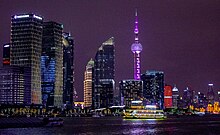
The newest Disney resort, with a Disneyland included, is located in Pudong, which is open to tourists in June 2016.[18]
Businesses[]
Bao Steel has its head office in the Bao Steel Tower (simplified Chinese: 宝钢大厦; traditional Chinese: 寶鋼大廈; pinyin: Bǎogāng Dàshà) in Pudong.[19] Comac has its head office in Pudong.[20] The headquarters of Yangtze River Express, a cargo airline, are in the Pufa Tower (浦发大厦; 浦发大廈; Pǔfā Dàshà) in Pudong.[21]
Hang Seng Bank has its mainland offices in the Hang Seng Bank Tower in Pudong.[22] Kroll has an office in the Hang Seng Bank Tower.[23] Google has its Shanghai offices in the Shanghai World Financial Center.[24]
Transportation[]
The Shanghai Pudong International Airport opened its doors in 1999, shortening the travel time for visitors.
In the same year, Line 2 of the Shanghai Metro commenced services. An extension brought the line further east, where it serves the airport. Other lines, namely Lines 4, 6, 7, 8, 9, 11, 12, 13 and 16 also have sections that serve parts of Pudong. A magnetic levitation train began operating in 2004, moving passengers between the airport and Longyang Road Metro station.

Pudong is connected to Puxi by several tunnels and four major bridges. The first of these bridges were the Nanpu Bridge (1991) and the Yangpu Bridge (1993). The Xupu Bridge opened in 1996. The latest of these is Lupu Bridge, which is the world's second longest arch bridge and was completed in 2002. Currently there are five tunnels that link the two sides, Dapu Rd. Tunnel, the first tunnel across the Huangpu River, Yan'an Rd. Tunnel, running east–west, and Dalian Rd. Tunnel, running north–south, Tunnel, complementing the Yan'an Rd. Tunnel, Waihuan Tunnel, one part of Shanghai Outer Ring Express. Two new tunnels linking Lujiazui to Puxi are under construction.
Roads in Pudong have no particular longitudinal or latitudinal orientation. Major thoroughfares Pudong Avenue, Zhangyang Road and Yanggao Road run east–west until Yangpu Bridge before turning gradually to become north–south. Century Avenue crosses all three major roads and extends from Lujiazui to Century Park. Yanggao Road extends south to the A20, Shanghai's outer Ring road, which runs east–west from Xupu Bridge and then north–south beginning at the interchange near Renxi Village, when the east–west expressway turns into Yingbin Avenue, headed for Pudong International Airport.
Metro[]
Pudong is currently served by ten metro lines and one tram line operated by Shanghai Metro and one maglev line operated by Shanghai Maglev Train and one suburban line operated by China Railway:
- Line 2 - Lujiazui, Dongchang Road, Century Avenue 4 6 9 , Shanghai Science and Technology Museum, Century Park, Longyang Road 7 16 Maglev , Zhangjiang Hi-Tech Park, Jinke Road, Guanglan Road, Tangzhen, Middle Chuangxin Road, East Huaxia Road, Chuansha, Lingkong Road, Yuandong Avenue, Haitiansan Road, Pudong International Airport Maglev
- Line 4 - Pudong Avenue, Century Avenue 2 6 9 , Pudian Road (4), Lancun Road 6 , Tangqiao
- Line 6 - Gangcheng Road 10 , North Waigaoqiao Free Trade Zone, Hangjin Road, South Waigaoqiao Free Trade Zone, Zhouhai Road, Wuzhou Avenue, Dongjing Road, Jufeng Road 12 , Wulian Road, Boxing Road, Jinqiao Road, Yunshan Road, Deping Road, Beiyangjing Road, Minsheng Road, Yuanshen Stadium, Century Avenue 2 4 9 , Pudian Road (6)), Lancun Road 4 , Shanghai Children's Medical Center, Linyi Xincun, West Gaoke Road 7 , Dongming Road 13 , Gaoqing Road, West Huaxia Road, Shangnan Road, South Lingyan Road, Oriental Sports Center 8 11
- Line 7 - Houtan, Changqing Road 13 , Yaohua Road 8 , Yuntai Road, West Gaoke Road 6 , South Yanggao Road, Jinxiu Road, Fanghua Road, Longyang Road 2 16 Maglev , Huamu Road
- Line 8 - China Art Museum, Yaohua Road 7 , Chengshan Road 13 , Yangsi, Oriental Sports Center 6 11 , Lingzhao Xincun Station
- Line 9 - Shangcheng Road, Century Avenue 2 4 6 , Middle Yanggao Road, Fangdian Road, Lantian Road, Taierzhuang Road, Jinqiao, Jinji Road, Jinhai Road 12 , Gutang Road, Minlei Road, Caolu
- Line 11 - Disney Resort, Kangxin Highway, Xiuyan Road, Luoshan Road 16 , Yuqiao, Pusan Road, East Sanlin, Sanlin, Oriental Sports Center 6 8
- Line 12 - Donglu Road, Jufeng Road 6 , North Yanggao Road, Jinjing Road, Shenjiang Road, Jinhai Road
- Line 13 - Shibo Avenue, Changqing Road 7 , Chengshan Road 8 , Dongming Road 6 , Huapeng Road, Xianan Road, Beicai, Chenchun Road, Lianxi Road, Middle Huaxia Road 16 , Zhongke Road, Xuelin Road, Zhangjiang Road
- Line 16 - Longyang Road 2 7 Maglev , Middle Huaxia Road 13 , Luoshan Road 11 , East Zhoupu, Heshahangcheng, East Hangtou, Xinchang, Wild Animal Park, Huinan, East Huinan, Shuyuan, Lingang Avenue, Dishui Lake
- Shanghai maglev train - Longyang Road 2 7 16 , Pudong International Airport 2
- Zhangjiang Tram - Zhangjiang Hi-Tech Park Station, Bibo Road-Gaoke Road Station, *Huatuo Road-Daerwen Road Station, Huatuo Road Keyuan-Road Station, Cailun Road-Jinke Road Station, Cailun Road-Halei Road, Gebaini Road-Libing Road, Ziwei Road-Gaosi Road, Gaosi Road-Zhangjiang Road, Zhangjiang Middle School, Guanglan Road-Zuchongzhi Road Station, Guanglan Road=Dangui Road Station, Dangui Road-Qingtong Road, Dangui Road-Zhangdong Road, Zhangdong Road–Jinqiu Road
- Pudong railway - ,
Gallery[]

The Oriental Pearl tower at night

Pudong from the Bund
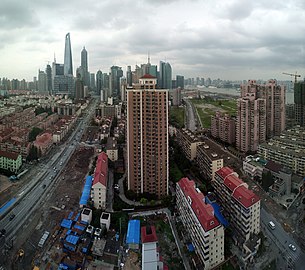
Panoramic view at Shanghai Pudong from the east
Jin Mao building

Shanghai's Pudong skyline towers over the Huangpu River
Lujiazui Finance and Trade Zone, Pudong
Lujiazui skyline, Pudong

CITIC Pacific HQ & Mandarin Oriental
Pudong at night (video)

Pudong at night with Oriental Pearl Tower
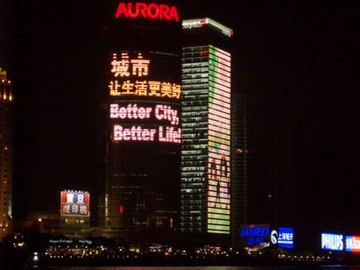
Huangpu River at night. “Better City, Better Life” is the theme of Expo 2010.

View of Pudong area at night time
View of the Oriental Pearl Tower
Ship in Front of Oriental Pearl Tower
Shanghai Oriental Pearl Tower
Lujiazui at night
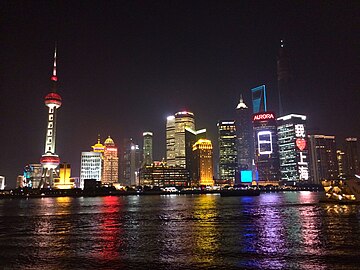
Lujiazui at night

Satellite image of Shanghai's Pudong district.
Twin towns — sister cities[]
Pudong is twinned with:
Central business district relations[]
Sister central business districts[]
 Manhattan, New York City, New York, United States
Manhattan, New York City, New York, United States
Friendship central business districts[]
 Manhattan, New York City, New York, United States
Manhattan, New York City, New York, United States
See also[]
- Manhattan
References[]
- ^ "2019年浦东地区生产总值增长7%".
- ^ 上海自贸区空间扩大4倍 将与浦东新区合署办公. People's Daily. April 27, 2015. Retrieved April 27, 2015.
- ^ (in Chinese) China Statistical Office. Data from the Sixth National Population Census of the People's Republic of China
- ^ Summary of Pudong Data from the Sixth National Population Census http://gov.pudong.gov.cn/pudongNews_inform/Info/Detail_365360.htm
- ^ Population analysis of Pudong, 2011 http://rkjsw.sh.gov.cn/dr/qxinfo/310115/2012227/000000003500038000944464363.html?openpath=spfp/qxinfo/310115 Archived 2015-01-09 at the Wayback Machine
- ^ Census Office of the State Council of the People's Republic of China; Population and Employment Statistics Division of the National Bureau of Statistics of the People's Republic of China (2012). 中国2010人口普查分乡、镇、街道资料 (1 ed.). Beijing: China Statistics Print. ISBN 978-7-5037-6660-2.
- ^ "Contact Us." Dulwich College Shanghai. Retrieved on October 12, 2013. "DCS MAIN CAMPUS 266 LanAn Rd, JinQiao, PuDong, 201206 地址:上海市浦东金桥蓝桉路266号,201206" and "DUCKS 425 LanAn Rd, Jin Qiao, PuDong 201206 地址:上海市浦东金桥蓝桉路425号,201206"
- ^ "Home Archived 2014-05-17 at the Wayback Machine." French School of Shanghai. Retrieved on 23 May 2014. "Campus de Pudong : 1555, Jufeng Lu, Pudong District 201208 Shanghai (Chine)"
- ^ "Kontakte." German School of Shanghai Pudong. Retrieved on 23 May 2014. "DS Shanghai Pudong 1100 Jufeng Lu 201206 Shanghai - VR China" - Chinese address: "上海德国学校浦东校园201206上海市巨峰路1100号综合楼"
- ^ Home page. Shanghai American School. Retrieved on February 19, 2014. "Puxi Campus 258 Jinfeng Road Huacao Town, Minhang Dist. Shanghai, China 201107 6221-1445" and "Pudong Campus Shanghai Links Executive Community 1600 Lingbai Road Sanjiagang, Pudong Shanghai, China 201201 6221-1445"
- ^ "Shanghai Japanese School Pudong Campus." Shanghai Japanese School. Retrieved on February 18, 2014. "上海日本人学校 浦東校 〒200127 上海市浦東新区錦康路277号"
- ^ "Home Archived 2014-02-22 at the Wayback Machine." SJS Senior High School. Retrieved on February 18, 2014. "〒200127 上海市浦東新区錦康路277号"
- ^ "Contact Us." Wellington College International Shanghai. Retrieved on September 30, 2015. "Wellington College No. 1500 Yao Long Road (near the Oriental Sports Center) Pudong, Shanghai 200126 上海惠灵顿国际学校 上海市浦东新区 耀龙路1500号 (靠东方体育中心) 邮编:200126"
- ^ "Concordia International School Shanghai". Home Page. Retrieved 16 November 2019.
- ^ 经济发展. 2016-12-08.
- ^ Knight Frank China Knight Frank China, Shanghai Commercial Market Quarterly Report, Q4 2009
- ^ Knight Frank China Knight Frank China, Shanghai Commercial Market Quarterly Report, Q1 2009
- ^ "[1]." THE WALT DISNEY COMPANY REACHES ANOTHER MAJOR MILESTONE ON SHANGHAI THEME PARK PROJECT. Retrieved on July 7, 2010.
- ^ "Contact Us." Baosteel. Retrieved on November 10, 2012. "ADD:Baosteel Tower, Pu Dian Road 370, Pudong New District, Shanghai, 200122, P.R. China Postal Code:200122" - Chinese: "上海市浦东新区浦电路370号宝钢大厦"
- ^ "Contact Us." Comac. Retrieved on November 10, 2012. "25 Zhangyang Road, Shanghai" - Chinese: "上海市张杨路25号"
- ^ "Yangtze River Express Airlines Company Limited Archived 2016-05-02 at the Wayback Machine." HNA Group. Retrieved on February 24, 2014. "Address: Pufa Tower, 588 Pudong South Road, Pudong New Area, Shanghai" - Address in Chinese Archived 2014-03-01 at the Wayback Machine: "地址:上海市浦东新区浦东南路588号浦发大厦 邮编:200120"
- ^ "Mainland Service Network." Hang Seng Bank. Retrieved on 11 September 2011. "Hang Seng Bank(China)Limited Address: 34/F & 36/F, Hang Seng Bank Tower, 1000 Lujiazui Ring Road, Pudong, Shanghai, China"
- ^ "Office locations Archived 2011-08-10 at the Wayback Machine." Kroll Inc. Retrieved on 14 August 2011. "Shanghai Room 3031, 30F 1000 Lujiazui Ring Road, Hang Seng Bank Tower Pudong New Area Shanghai 200120 China"
- ^ "Google locations." Google. Retrieved on May 25, 2016. "Google Shanghai 60F, Shanghai World Financial Center 100 Century Avenue, Pudong New Area Shanghai 200120, China"
- ^ "Sister Cities Committee". City of Beverly Hills. 2019-07-01. Retrieved 2019-07-01.
- ^ "Vice Chairman of Shanghai visited Kuopio". Kuopio Innovation. 2013-06-04. Retrieved 2015-12-01.
Further reading[]
- Kris Olds, “Globalizing Shanghai: The ‘Global Intelligence Corps’ and the Building of Pudong," Cities 12, no. 3 (1997) 109–23.
External links[]
| Wikimedia Commons has media related to Pudong New Area. |
| Wikivoyage has a travel guide for Pudong. |
- Pudong
- New areas (China)
- Districts of Shanghai
- Special Economic Zones of China
- Central business districts in China


















